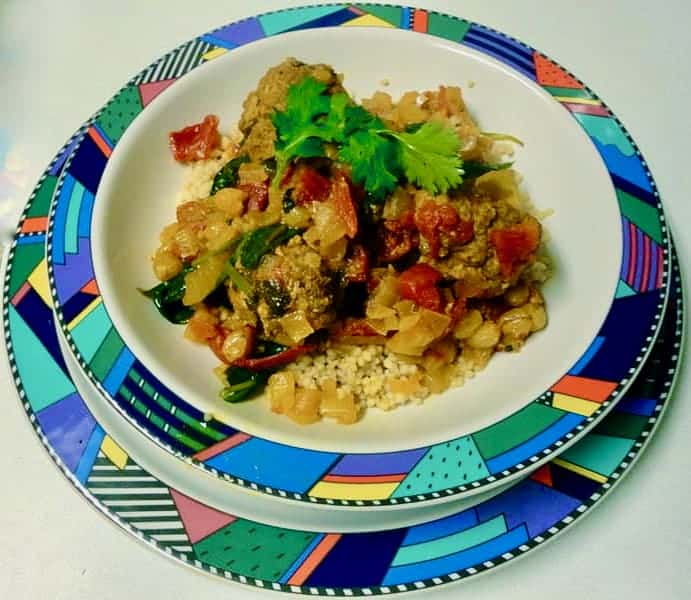Moroccan Beef Meatball Tagine from Jean Thiel Kelley in Bon Appetit
For the Meatballs:
1 1/2 pounds ground beef (20{4e4771bbe073b579fdd8e596ee487f65145483febbc8ba0a80525f62b26cad86} fat)
1/3 cup coarsely grated onion
1/3 cup panko (Japanese breadcrumbs)*
1/4 cup chopped fresh cilantro
1 large egg, beaten to blend
2 garlic cloves, minced
1 teaspoon turmeric
1/2 teaspoon cayenne pepper
1/2 teaspoon ground cinnamon
1/2 teaspoon ground nutmeg
1/2 teaspoon freshly ground black pepper
1/2 teaspoon coarse kosher salt
1/4 teaspoon ground ginger
For the Stew:
1 tablespoon olive oil
3 1/2 cups chopped onions
4 garlic cloves, minced
2 cinnamon sticks
1 teaspoon turmeric
1/8 teaspoon saffron threads, crumbled
2 cups beef broth
1 14.5-ounce can diced tomatoes in juice
1/4 cup golden raisins
2 cups 1/2-inch-thick carrot slices (diagonally)
1/4 cup chopped fresh cilantro plus additional for garnish
1 5-ounce package baby spinach leaves
Couscous with Fresh Cilantro and Lemon Juice
Lemon wedges (for garnish)
To make the meatballs:
Line large rimmed baking sheet with plastic wrap.
Gently mix all ingredients in large bowl.
Using moistened hands and scant 2 tablespoonfuls for each, roll meat mixture into 1 1/2-inch meatballs. Arrange meatballs on sheet.
To make the stew:
Heat oil in heavy large ovenproof pot over medium heat.
Add onions; sauté about 15 minutes.
Add garlic, cinnamon, turmeric, and saffron; stir 2 minutes. Add broth, tomatoes with juice, and raisins.
Preheat oven to 350°F. Bring stew to simmer. Stir in carrots. Carefully add meatballs to stew; gently press into liquid to submerge. Sprinkle 1/4 cup cilantro over. Cover pot; place in oven.
Bake until meatballs are cooked through and carrots are tender, about 35 minutes.
Sprinkle spinach over stew. Cover and bake until spinach wilts, about 5 minutes longer.
Gently stir to mix in spinach, being careful not to break meatballs. Remove cinnamon sticks. Season tagine with salt and pepper.
Spoon couscous into bowls; top with tagine. Garnish with cilantro and lemons.
